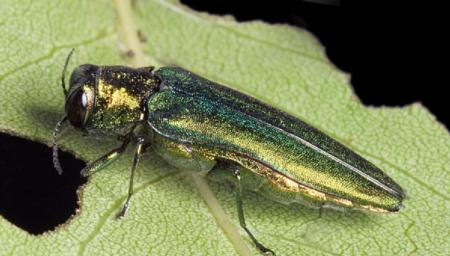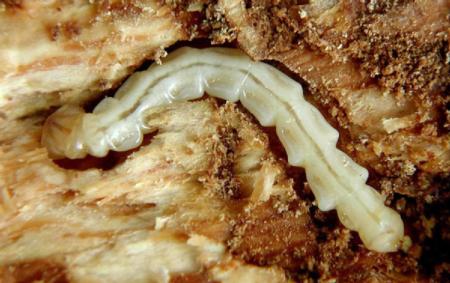INSECT HOT TOPICS: Emerald ash borer on the move
by James A. Bethke
Some of the most attractive insects on the planet can also be some of the most deadly — not to humans, but to plants. For example, the emerald ash borer (EAB for short), Agrilus planipennis (Fairmaire) (Coleoptera: Buprestidae), is a boring beetle that is quite attractive (fig. 1). The beetle is small, only 0.39 to 0.51 inches (10 to 13 mm) long, and metallic green. Essentially all ash trees (Fraxinus spp.) are disappearing in areas that are infested with this beetle, and all species of ash appear to be susceptible. Indeed, it has been estimated that EAB has killed at least 50 to 100 million ash trees so far. In California, we have a couple of species of boring beetles and other beetles that are also metallic green, and the native Pacific flatheaded borer can cause significant damage to backyard fruit trees (see links below for information about these beetles). However, the local beetles are not as devastating as the invasive EAB, which is now considered one of the most destructive non-native insects in the United States.

Fig. 1. Emerald ash borer adult. Photo by David Cappaert, Michigan State University, Bugwood.org.
EAB is originally from eastern Russia, northern China, Japan and Korea. However, it is moving fast in North America, spreading across the United States and Canada in all cardinal directions from its original detection site in Michigan in May 2002. Its presence has been confirmed in Ohio (2003), Indiana (2004), Illinois (2006), Maryland (2006), Pennsylvania (2007), West Virginia (2007), Virginia (2008), Wisconsin (2008), Missouri (2008), Minnesota (2009), Kentucky (2009), New York (2009), Iowa (2010), Tennessee (2010), Connecticut (2012) and Kansas (2012).
EAB passes through four instars before pupating near the bark and emerging as an adult. The larvae are creamy white, and dorso-ventrally flattened. As they feed on the cambium layer or vascular system of the plant, they create long serpentine galleries filled with frass, which enlarge in width as they grow, eventually girdling and killing the tree. When fully mature, fourth-instar larvae (fig. 2) are 1.02 to 1.26 inches (26 to 32 mm) long. EAB adults feed on foliage and both sexes are good fliers.

Fig. 2. Emerald ash borer larva. Photo by David Cappaert, Michigan State University, Bugwood.org.
Initial symptoms of an EAB attack begin with a general yellowing and thinning of the foliage. Branches begin to die from the top of the tree downward and the tree eventually dies. Typical signs of an EAB-infected tree are the presence of D-shaped emergence holes about 1/8 inch diameter, serpentine tunneling under the bark, or the presence of the adult or larvae in infested trees. It is common for all the trees in a single neighborhood to die synchronously. In a typical small town situation, 60 to 70% of the ash trees will begin to die within 4 years following an infestation, and eventually all the local ash trees will die.
Ash is an important species in U.S. timber production so quarantines imposed by state and federal agencies back east have caused substantial economic losses for plant and wood products industries. Further, the cost of removing infested trees and replanting has been staggering. This is because ash has been extensively used as a landscape tree in urban/suburban areas due to its tolerance of adverse site conditions. In addition to economic impacts, EAB has significant potential to change our urban and natural ecosystems: In natural forests, this pest may drastically change the forest composition; in urban areas, infested trees that are dead and dying trees will pose hazards to local residents and property.
One of the primary methods of transport of EAB is in firewood. Moving firewood and other ash wood materials in areas infested with this pest is heavily regulated. California nursery growers need to take EAB seriously and be on the lookout because movement of ash trees and maintenance of stock trees will be difficult in quarantine areas.
For general information about EAB, economic impacts and frequently asked questions, see the following web sites.
http://www.insectidentification.org/insect-description.asp?identification=Emerald-Ash-Borer
http://en.wikipedia.org/wiki/Emerald_ash_borer
http://journalistsresource.org/studies/environment/sustainability/invasive-forest-insects/
http://www.invasivespeciesinfo.gov/animals/eab.shtml#.UE7YFhh5lTc
http://www.emeraldashborerfaq.com/
For a map with links to the spread and infestation, as well as information about EAB in other states, including the newest reported infestation in Kansas see the following links.
http://www.emeraldashborer.info/
www.ksda.gov/plant_protection/content/379
For a good sequence of photos and a short film, see the following links.
http://www.hungrypests.com/the-threat/emerald-ash-borer.php
http://archive.org/details/gov.usda.aphis.green.menace
For information about other metallic beetles and the native Pacific flatheaded borer, see the following links.
www.ipm.ucdavis.edu/PMG/GARDEN/FRUIT/PESTS/grfruitbeetle.html?printpage
http://www.ipm.ucdavis.edu/PMG/r602300811.html
http://research.pomona.edu/bfs/2012/08/25/recent-additions-to-the-bfs-invert-list-2/
http://www.realmonstrosities.com/2012/01/tiger-beetle.html
http://waynesword.palomar.edu/ww0502.htm
James Bethke is Farm Advisor for Nurseries and Floriculture, UC Cooperative Extension, San Diego and Riverside Counties.












